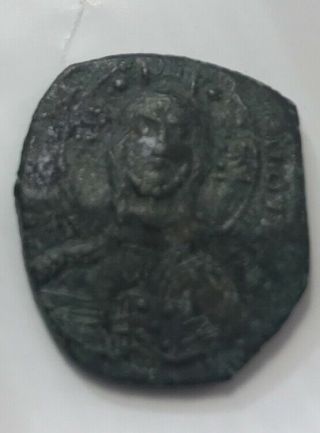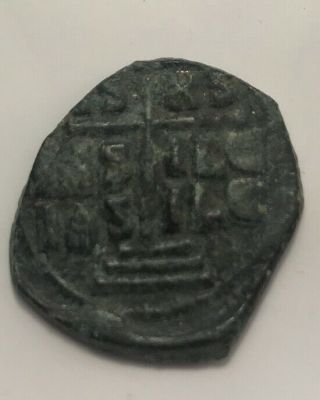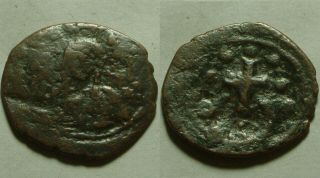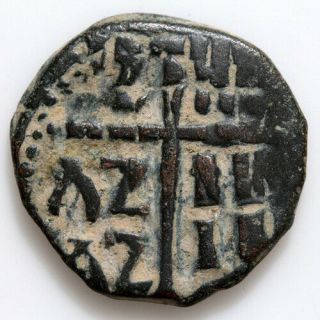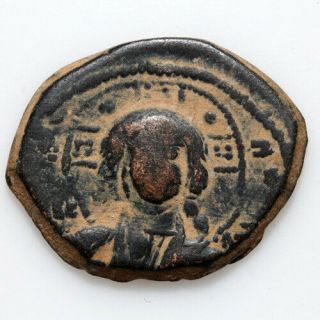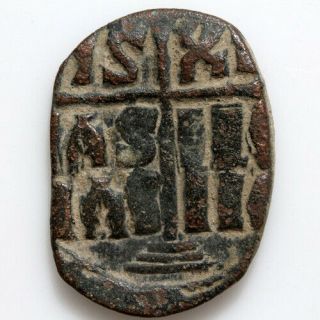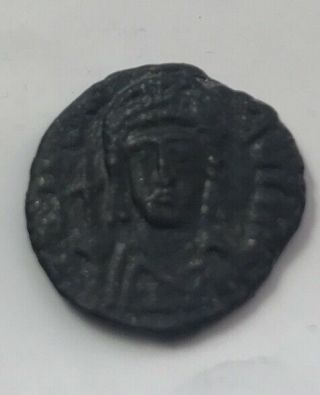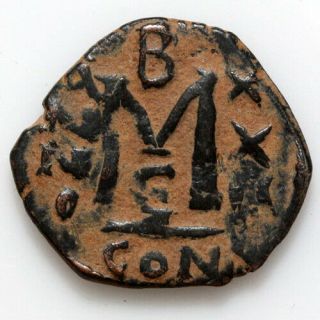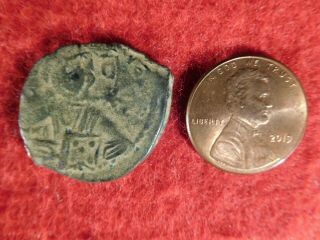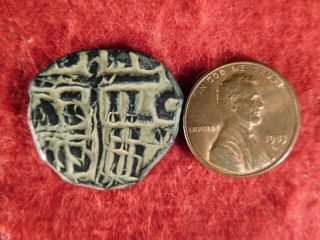Rare Ancient BYZANTINE Coin Anonymous Follis Romanus III Christ / Cross
Item History & Price
| Reference Number: Avaluer:21622133 |
One original ancient Byzantine coin:
Romanus III. 1028-1034 AD. Class B anonymous follis, 1028-1034 AD. Constantinople mint
Obv./ IC-XC to right and left of bust of Christ facing with nimbate cross behind head, square in each limb of nimbus cross, holding book of gospels, a dot in centre of dotted square on book.
Rev./ IS-XS BAS-ILE BAS-ILE to left and right above and below cross with dots at the ends, on three steps.
SB 1823Authenticity guaranteed!
AE 2...3-28mm. 8.82gm. Original glossy green-brown patina.
Lightly cleaned. Exactly as pictured.
Authenticity guaranteed.For more than a century, the production of Follis denomination Byzantine coins had religious Christian motifs which included included Jesus Christ, and even Virgin Mary. These coins were designed to honor Christ and recognize the subservient role of the Byzantine emperor, with many of the reverse inscriptions translating to "Jesus Christ King of Kings" and "May Jesus Christ Conquer". The Follis denomination coins were the largest bronze denomination coins issued by the Byzantine empire, and their large size, along with the Christian motif make them a popular coin type for collectors. Read more and see examples of these coins by reading theJESUS CHRIST Anonymous Class A-N Byzantine Follis Coins Reference.Jesus of Nazareth (c. 5 BC/BCE – c. 30 AD/CE), also referred to as Jesus Christ or simply Jesus, is the central figure of Christianity. MostChristian denominations venerate him asGod the Sonincarnated and believe that herose from the dead after beingcrucified.The principal sources of information regarding Jesus are the four canonical gospels, and mostcritical scholars find them, at least theSynoptic Gospels, useful for reconstructing Jesus’ life and teachings. Some scholars believe apocryphal texts such as the Gospel of Thomas and the Gospel according to the Hebrews are alsorelevant.Most critical historians agree that Jesus was aJew who was regarded as a teacher andhealer, that hewas baptized byJohn the Baptist, andwas crucified inJerusalem on the orders of theRoman PrefectJudaea, Pontius Pilate, on the charge ofsedition against the Roman Empire. Critical Biblical scholars and historians have offered competing descriptions of Jesus as a self-describedMessiah, as the leader of an apocalyptic movement, as an itinerant sage, as a charismatic healer, and as the founder of an independent religious movement. Most contemporary scholars of theHistorical Jesus consider him to have been an independent, charismatic founder of a Jewish restoration movement, anticipating an imminent apocalypse. Other prominent scholars, however, contend that Jesus' "Kingdom of God" meant radical personal and social transformation instead of a future apocalypse.Christians traditionally believe that Jesus wasborn of a virgin:529–32 performedmiracles, :358–59 foundedthe Church, rose from the dead, andascended intoheaven, :616–20 from which hewill return.:1091–109 Most Christian scholars today present Jesus as the awaited Messiah promised in the Old Testament and as God, arguing that he fulfilled many Messianic prophecies of the Old Testament. The majority of Christians worship Jesus as the incarnation of God the Son, one of three divine persons of a reject TrinitarianismTrinity, wholly or partly, believing it to be non-scriptural.Judaismrejects assertions that Jesus was the awaited Messiah, arguing that he did not fulfill theMessianic prophecies in theTanakh. In Islam, Jesus (Arabic:عيسى, commonly transliterated asIsa) is considered one ofGod's importantprophets, a bringer ofscripture, and the product of a virgin birth; but did not experience a crucifixion. Islam and theBaha'i Faith use the title "Messiah" for Jesus, but do not teach that he was God incarnate.Romanos III Argyros, or Romanus III Argyrus (Greek: Ρωμανός Γ΄ Αργυρός, Rōmanos III Argyros; 968 – 11 April 1034), was Byzantine emperor from 15 November 1028 until his death. He was a Byzantine noble and senior official in Constantinople when the dying Constantine VIII forced him to divorce his wife and marry the emperor's daughter Zoë. Upon Constantine's death three days later, Romanos took the throne. Romanos has been recorded as a well meaning but ineffective emperor. He disorganised the tax system and undermined the military, personally leading a disastrous military expedition against Aleppo. He fell out with his wife and foiled several attempts on his throne, including two which revolved around his sister-in-law Theodora. He spent large amounts on the construction and repair of churches and monasteries. He died after six years on the throne, allegedly murdered, and was succeeded by his wife's young lover, Michael IV. The Byzantine Empire, or Eastern Roman Empire, was the predominantly Greek-speaking eastern half continuation and remainder of the Roman Empire during Late Antiquity and the Middle Ages. Its capital city was Constantinople (modern-day Istanbul), originally founded as Byzantium. It survived the fragmentation and fall of the Western Roman Empire in the 5th century AD and continued to exist for an additional thousand years until it fell to the Ottoman Turks in 1453. During most of its existence, the empire was the most powerful economic, cultural, and military force in Europe. Both "Byzantine Empire" and "Eastern Roman Empire" are historiographical terms created after the end of the realm; its citizens continued to refer to their empire as the Roman Empire (Ancient Greek: Βασιλεία Ῥωμαίων, tr. Basileia Rhōmaiōn; Latin: Imperium Romanum), or Romania (Ῥωμανία), and to themselves as "Romans".Several events from the 4th to 6th centuries mark the transitional period during which the Roman Empire's east and west divided. In 285, the emperor Diocletian (r. 284–305) partitioned the Roman Empire's administration into eastern and western halves. Between 324 and 330, Constantine I (r. 306–337) transferred the main capital from Rome to Byzantium, later known as Constantinople ("City of Constantine") and Nova Roma ("New Rome"). Under Theodosius I (r. 379–395), Christianity became the Empire's official state religion and others such as Roman polytheism were proscribed. And finally, under the reign of Heraclius (r. 610–641), the Empire's military and administration were restructured and adopted Greek for official use instead of Latin. Thus, although it continued the Roman state and maintained Roman state traditions, modern historians distinguish Byzantium from ancient Rome insofar as it was oriented towards Greek rather than Latin culture, and characterised by Orthodox Christianity rather than Roman polytheism.The borders of the Empire evolved significantly over its existence, as it went through several cycles of decline and recovery. During the reign of Justinian I (r. 527–565), the Empire reached its greatest extent after reconquering much of the historically Roman western Mediterranean coast, including north Africa, Italy, and Rome itself, which it held for two more centuries. During the reign of Maurice (r. 582–602), the Empire's eastern frontier was expanded and the north stabilised. However, his assassination caused a two-decade-long war with Sassanid Persia which exhausted the Empire's resources and contributed to major territorial losses during the Muslim conquests of the 7th century. In a matter of years the Empire lost its richest provinces, Egypt and Syria, to the Arabs.During the Macedonian dynasty (10th–11th centuries), the Empire again expanded and experienced a two-century long renaissance, which came to an end with the loss of much of Asia Minor to the Seljuk Turks after the Battle of Manzikert in 1071. This battle opened the way for the Turks to settle in Anatolia as a homeland.The final centuries of the Empire exhibited a general trend of decline. It struggled to recover during the 12th century, but was delivered a mortal blow during the Fourth Crusade, when Constantinople was sacked and the Empire dissolved and divided into competing Byzantine Greek and Latin realms. Despite the eventual recovery of Constantinople and re-establishment of the Empire in 1261, Byzantium remained only one of several small rival states in the area for the final two centuries of its existence. Its remaining territories were progressively annexed by the Ottomans over the 15th century. The Fall of Constantinople to the Ottoman Empire in 1453 finally ended the Byzantine Empire.
Please make your payments on time. Payment methods for USA buyers:< PAYPAL
Payment methods for International buyers - including Canada: PAYPAL, contact us for more info. Payments must be received within 7 days from the end of auction (14 days for international).
Please be sure to include item # & address with your payment. IF REQUESTING A CERTIFICATE PLEASE DO SO AT THE TIME OF PAYMENT. Pay me securely with any major credit card through PayPal!
Items will be shipped within 1 to 3 business days of purchase completion.
FREE DOMESTIC first class SHIPPING.
INTERNATIONAL $7
(REGISTERED-$21.00)
WE COMBINE SHIPPING. ($1 for each additional item.)
If you would like to have special shipping, please contact us.
All items will be sent out in protected envelope and boxed if necessary.
YOU ARE BIDDING ON AN ANCIENT ITEM(S) AS DESCRIBED AND PICTURED ABOVE!!!
Every item offered by cameleoncoins is unconditionally guaranteed to be genuine & authentic.
We can provide a certificate of authenticity or extended return policy by request only!!!
If in the unlikely event that an item is found to be reproduction, full return privileges are within 14 days of receiving the coins.
We will promptly offer a full refund without hesitation or hassle.




